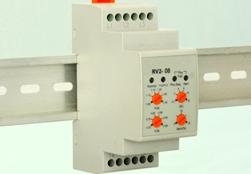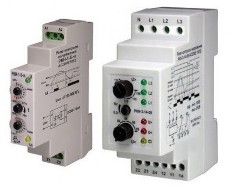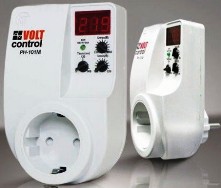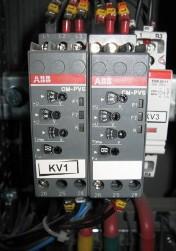Categories: Featured Articles » Electrician Secrets
Number of views: 301778
Comments on the article: 19
Voltage relay: what are, how to choose and connect?
 Today, there is a huge number of a wide variety of household appliances, which are equipped with more and more intelligent electronics every year, reduced in size, change their design, shape and color. But nevertheless, despite this, one thing has remained unchanged for many years: today, like ten and twenty years ago, the stable operation of electrical equipment is completely dependent on the quality of electricity.
Today, there is a huge number of a wide variety of household appliances, which are equipped with more and more intelligent electronics every year, reduced in size, change their design, shape and color. But nevertheless, despite this, one thing has remained unchanged for many years: today, like ten and twenty years ago, the stable operation of electrical equipment is completely dependent on the quality of electricity.
How many troubles caused sharp failures and peak bursts in everyday life and in production mains voltage? Workshop workers and firefighters know best about this.
Is it possible to minimize the number of failures of household appliances and equipment due to unstable voltage? It turns out you can. It is enough to carry out the electrical installation only in the load circuit voltage relay. This protection device is able to de-energize the power supply in a split second at any power surge or drop.
 Voltage relay - This is a device that is a combination of an electronic device for monitoring the voltage and power part of the load disconnector, assembled in one case.
Voltage relay - This is a device that is a combination of an electronic device for monitoring the voltage and power part of the load disconnector, assembled in one case.
The "heart" of the voltage relay can be made on the basis of a microprocessor or simple comparator. At the same time, the microprocessor voltage relays are characterized by a more smooth adjustment of the upper and lower thresholds.
The main parameter of the voltage relay is speed. Moreover, the response time of some relays is only tens of nanoseconds. The threshold is set by a potentiometer on a graduated scale.
Unlike voltage stabilizer the voltage relay does not equalize the voltage in the network, but only instantly turns off the protected area when the voltage rises or falls and automatically turns it on when the voltage stabilizes in the network. Therefore, it is very effective in emergency situations that arise as a result of a neutral break, overload, phase imbalance, etc.
Depending on the type of connection, the voltage relays are divided into:
 - Voltage relay plug-socket (V-protector 16AN, RN-101M).
- Voltage relay plug-socket (V-protector 16AN, RN-101M).
Such a voltage relay is installed directly in the outlet and is used to protect individual consumers or their groups. Relay controlled by microcontroller, which analyzes the current supply voltage and displays it effective value on a digital display. The load is disconnected by an electromagnetic relay. The buttons are used to set acceptable limits and delay times.
- Extension voltage relay (RN-101M, ZUBR P616y, V-protector 10Acy).
This device is similar to the previous one, the only difference is that the voltage-extension relay can have two or more sockets. That is, with its help you can simultaneously protect, for example: a refrigerator and a TV or a washing machine, a refrigerator and air conditioning;
- Voltage relay for mounting on a DIN rail (V-protector 16-80A, ZUBR D340t).
This relay is intended for installation in a control cabinet. The great advantage of this device is that with its help you can protect not only a certain group of consumers, but also the whole house or apartment.
 Typically, such relays have a wide range of adjustments and can operate in several independent modes, for example: as a voltage relay, as a minimum voltage relay, as a maximum voltage relay, as time delay relay.
Typically, such relays have a wide range of adjustments and can operate in several independent modes, for example: as a voltage relay, as a minimum voltage relay, as a maximum voltage relay, as time delay relay.
Switching the load, the power of which does not exceed 8.5 kVA, is carried out directly by the voltage relay contacts. If the load power exceeds 8.5 kVA, then to disconnect it, use magnetic switchcontactor or circuit breaker appropriate power.
Also, voltage relays are divided into single-phase and three-phase. It is clear that if the load is single-phase, then single-phase relays should be used to protect it.
Three phase voltage relays used to protect three-phase motors and three-phase equipment. They are perfect for protection against overvoltage and phase failure of air conditioning, refrigeration, compressor units, machine tools and other equipment with an electric drive.
They are equally effective in monitoring systems for the full-phase and quality of the mains voltage. If the room is equipped with a three-phase input, then you can, of course, put a three-phase relay as protection against power surges. But, if one of the phases disappears, the three-phase voltage relay will disconnect the remaining two, since the operation of three-phase motors in this mode is unacceptable.
In addition, the three-phase relay will operate even with a slight phase imbalance, as this is also a dangerous mode for motors. For example: if you have 220 V in one phase and 230 V in the second, a three-phase relay will de-energize the whole house, even though such a voltage is absolutely normal for most household appliances. Therefore, if you do not have three-phase consumers, it is best to put on each phase single phase voltage relay.
It is necessary to choose a voltage relay with 20 - 30% power reserve. Since the rating of the current for which the voltage relay is designed means the current strength that the relay is able to miss, but not open. That is, if 25 A is written on your circuit breaker, then you can take a 32 A or 40 A voltage relay.
Video on the topic. Overvoltage protection. Protection of equipment and household appliances from high voltage. This topic is relevant for the old fund, where the wiring is done according to the old standards, not designed for the abundance of household appliances in each apartment.
See also at e.imadeself.com
:
